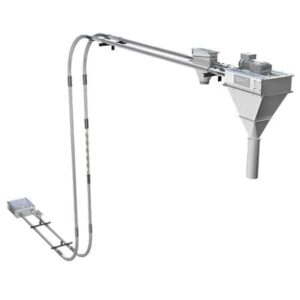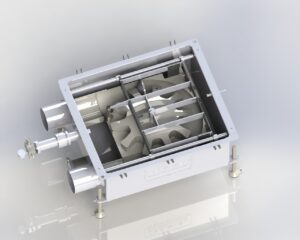Cablevey Conveyors is long-established as one of the leading suppliers of tubular drag cable conveyors for whole bean and ground coffee. The flexibility of its technology is demonstrated by equipment for two completely different types of product – whole bean coffee and cocoa nibs
The first application of Cablevey Conveyors technology saw the US-based company provide Swiss Water Decaffeinated Coffee Company (SWDCC) in Burnaby, British Colombia with conveying technology for decaffeinated green coffee beans.
SWDCC prides itself on the quality of its decaffeinated coffee, which is produced using the Swiss Water process. Green coffee is generally considered to be pretty ‘hardy’ when it comes to being handled, but SWDCC observed some deterioration in bean quality within its operation and after extensive research determined that bean delamination and breakage was taking place whilst the product was being conveyed.
Traditionally, SWDCC utilised pneumatic conveyors, drag chains, and bucket elevators to convey decaffeinated green coffee beans, but decided it wanted a conveyor that would be gentler on the product; a conveyor that would be able to accommodate multiple inlets and multiple outlets; and a conveyor that was sufficiently flexible to operate in their existing plant layout. Essentially, they wanted a conveyor that would have the product protection of a bucket elevator (or more), but with the layout flexibility of a pneumatic conveyor.
Conveyors and elevators replaced

HVJResponding to SWDCC’s needs, Cablevey supplied a 6in conveyor capable of moving 52,000 lb/hour (23,500kg/hour) of green beans from the outlets of a bank of silos to two packaging stations. One Cablevey system replaced three drag chain conveyors and one bucket elevator. Removing the transition points opened up the area considerably due to a reduction in the number of drive units, which also resulted in fewer points of failure and ultimately in less product damage.
Immediately after commissioning it was apparent that the Cablevey Conveyor was very quiet, much quieter than the systems it replaced and any other conveyors in the facility. Cablevey’s sealed unit and the continuous wiping on the interior of the conveying tubes ensured that the system was kept clean on a continuous basis. Together with the removal of the transition points, there are now no areas where beans can become caught. Consequently, the opportunities for cross contamination from one batch to another were removed and the cleanout time that was required in the previous system has become unnecessary.
Cable Conveyors: A Positive Investment
Installing the Cablevey equipment also led to a reduction in energy consumption through the replacement of four drive units with a single 5hp motor, and the primary justification for choosing the company’s technology – reduced product damage – was met with no measurable damage of any type being caused by the new conveyor.
SWDCC spokesperson Charles Carrier said: “Overall, Cablevey has been a positive investment in improving process capability, product integrity and consistency, resulting in enhanced customer service and satisfaction.”
The second application of Cablevey technology was in the cocoa market, rather than coffee and was undertaken on behalf of Cadbury, the multinational chocolate manufacturer, at its plant in Singapore. The product to be transported is cocoa nibs.
The Singapore facility processes a range of products, including cocoa. Raw cocoa beans are roasted into cocoa nibs, and then processed into cocoa powder, cocoa butter and other products. Like other processors, the company utilised traditional conveyors such as pneumatic conveyors and bucket elevators. However, cocoa beans and cocoa nibs can be quite abrasive and cause problems in many conveying systems.
A spokesperson for Cablevey said the client had problems with a pneumatic conveyor conveying cocoa nibs. The conveyor accepted the hot nibs from an auger and fed them to two silos in separate rooms. Sometimes, the conveyor would become blocked due to variations in the product or aspiration failure, and the driving force of the conveying air was insufficient to break through. The company therefore needed a conveyor that had a mechanical drive, which would not experience blockages, and had the flexible layout to match existing sources and destinations.
Cablevey supplied a 4in conveyor capable of moving 21,000lb/hour (9,500kg/hour) of cocoa nibs to replace their old pneumatic conveyor. The components removed from the old conveyor included a high energy blower, a rotary valve, two cyclones and two dust takeaway systems. The rotary valve could be removed as the feed into the inlet of the Cablevey conveyor was sufficiently regulated by the auger feeding it.
After commissioning it was apparent once again how quiet the Cablevey equipment was. “If the visual inspection tube wasn’t installed, it would be difficult to determine it was actually operating,” said the company. “Even with the blower located in a separate blower room, the old pneumatic conveyor significantly added to the overall noise level.”
Power savings
Adding up the power ratings on all of the motors on the old pneumatic system and comparing the total with the single 5hp motor on the new Cablevey equipment resulted in an estimated 70 per cent reduction in power consumption.
The installation is still only a few weeks old, but so far it has not experienced any blockages and the client wants to investigate replacing other traditional conveyors but wants to evaluate the Cablevey for a few more months to ensure it is operating smoothly. One possibility is to replace all of its pneumatic conveyors, as this would free-up a noisy under-utilized space in the blower room.
Cablevey Conveyors
Oskaloosa, IA
800-247-3344
www.cablevey.com






